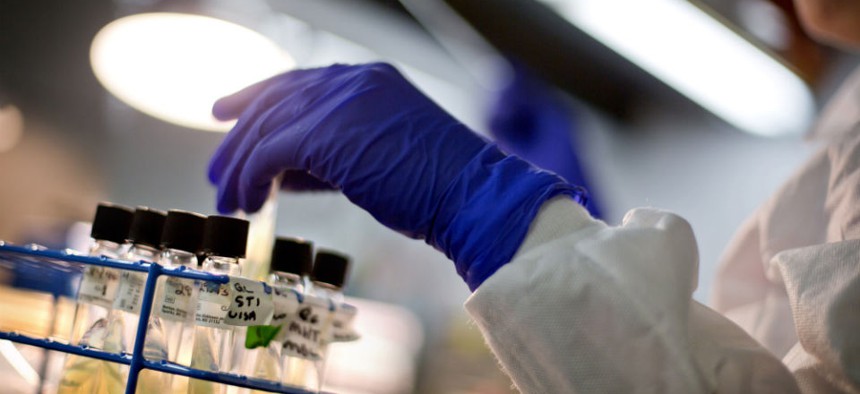
Microbiologist Tatiana Travis works with tubes of bacteria samples in an antimicrobial resistance and characterization lab within the Infectious Disease Laboratory at the federal Centers for Disease Control and Prevention. David Goldman/AP
Scientists Just Found Stray Vials of Smallpox From the 1950s
Samples were found in an unused section of a storage room in a Food and Drug Administration laboratory in Maryland.
If there's one thing you generally want to keep tabs on, it's a deadly virus that has killed an estimated 300 million people in the 20th century alone.
But a few vials of smallpox, which was officially declared eradicated worldwide in 1979, managed to go unnoticed for decades in a storage room, according to a statement by the Centers for Disease Control and Prevention on Tuesday.
On July 1, officials from the National Institutes of Health told the CDC's Division of Select Agents and Toxins that employees had discovered vials labeled "variola," the Latin name of smallpox, on the NIH's Bethesda campus in Maryland. The samples, which appear to be from the 1950s, were found in an unused section of a storage room in a Food and Drug Administration laboratory.
Scientists stumbled upon the vials as they prepped for the laboratory's move to the FDA's main campus in Silver Spring, Md. The FDA has operated this laboratory, among others, on NIH's campus since 1972.
The vials were immediately rushed to a CDC-registered agent-containment laboratory in Bethesda. They were transported to a CDC high-containment facility in Atlanta on Thursday, accompanied by federal and local law-enforcement agencies and, we hope, stored in a very large box. In the next two weeks, scientists will test the smallpox virus inside the vials to determine whether it's viable—that is, whether it can grow in a petri dish of tissue culture. After that, all of the vials will be destroyed.
Only two samples of the smallpox disease remain in the world. One is held at CDC headquarters in Atlanta, and the other at the State Research Centre of Virology and Biotechnology in Novosibirsk, Russia. More than 30 years after eradication, the debate over whether these samples should still exist continues. Opponents of continued storage say there's no real reason to hang onto the clearly hazardous samples. Why keep the risk alive? Supporters of storage say the samples could be useful in further research, in case the virus still exists elsewhere and resurfaces as a biological weapon.
The last medical case of smallpox in the United States was in 1949.
Following the discovery in Maryland, the CDC has invited the World Health Organization, which oversees the security of existing smallpox repositories, into its investigation of the samples. The CDC's Division of Select Agents and Toxins and the FBI are looking into how these samples got there. May we suggest looking at the intern first?







